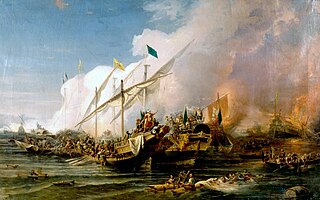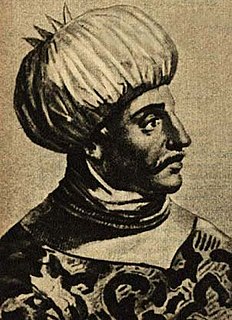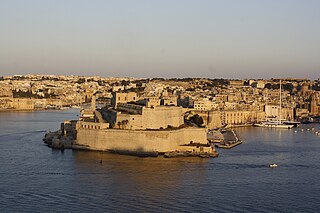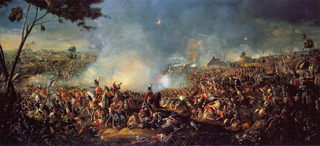
The Battle of Lepanto was a naval engagement that took place on 7 October 1571 when a fleet of the Holy League, led by the Venetian Republic and the Spanish Empire, inflicted a major defeat on the fleet of the Ottoman Empire in the Gulf of Patras. The Ottoman forces were sailing westward from their naval station in Lepanto when they met the fleet of the Holy League which was sailing east from Messina, Sicily. The Holy League was a coalition of European Catholic maritime states which was arranged by Pope Pius V and led by John of Austria. The league was largely financed by Philip II of Spain, and the Venetian Republic was the main contributor of ships.

The Battle of Preveza was a naval battle that took place on 28 September 1538 near Preveza in northwestern Greece between an Ottoman fleet and that of a Christian alliance assembled by Pope Paul III in which the Ottoman fleet defeated the allies. It occurred in the same area in the Ionian Sea as the Battle of Actium, 31 BC. It was one of the three largest sea battles that took place in the sixteenth century Mediterranean.

The Holy League of 1571 was arranged by Pope Pius V and included the major Catholic maritime states in the Mediterranean except France. It was intended to break the Ottoman Turks' control of the eastern Mediterranean Sea and was formally concluded on 25 May 1571. Its members were:

Occhiali was an Italian farmer, then Ottoman privateer and admiral, who later became beylerbey of the Regency of Algiers, and finally Grand Admiral of the Ottoman fleet in the 16th century.

The Third Battle of the Dardanelles in the Sixth Ottoman-Venetian War took place on 26 and 27 June 1656 inside the Dardanelles Strait. The battle was a clear victory for Venice and the Knights Hospitaller over the Ottoman Empire, although their commander, Lorenzo Marcello, was killed on the first day.
Action of 27 August 1661 was a naval battle that took place on 27 August 1661 near Milos, Greece between the Republic of Venice and the Knights Hospitaller over the Ottoman Empire.

The naval Battle of Matapan took place on 19 July 1717 off the Cape Matapan, on the coast of the Mani Peninsula in southern Greece, between the Armada Grossa of the Republic of Venice, supported by a mixed squadron of allied ships from Portugal, the Papal States and Malta, and the Ottoman fleet, under Kapudan Pasha Eğribozlu İbrahim Pasha.

The Battle of Malta took place on 8 July 1283 in the entrance to the Grand Harbour, the principal harbour of Malta, as part of the War of the Sicilian Vespers. An Aragonese fleet of galleys, commanded by Roger of Lauria, attacked and defeated a fleet of Angevin galleys commanded by Guillaume Cornut and Bartholomé Bonvin.
The Action of 26 June 1625 is the battle which took place on 26 June 1625 near Syracuse, Sicily, when 6 Bizertan vessels defeated 5 Maltese galleys.

The Battle of Djerba took place in May 1560 near the island of Djerba, Tunisia. The Ottomans under Piyale Pasha's command overwhelmed a large joint Christian Alliance fleet, composed chiefly of Spanish, Papal, Genoese, Maltese and Neapolitan forces. The allies lost 27 galleys and some smaller vessels as well as the fortified island of Djerba. This victory marked perhaps the high point of Ottoman power in the Mediterranean Sea.

The Raid on Mounts Bay also known as the Spanish attack on Mounts Bay was a Spanish raid on Cornwall, England, that took place between 2 and 4 August 1595 during the Anglo-Spanish war of 1585-1604. It was conducted by a Spanish naval squadron led by Carlos de Amésquita on patrol from Brittany, France. The Spanish made landfall in Mount's Bay then sacked and burned Newlyn, Mousehole, Penzance and Paul, beating a militia force under Francis Godolphin in the process.

The Siege of Tripoli occurred in 1551 when the Ottomans besieged and vanquished the Knights of Malta in the fortress of Tripoli, modern Libya. The Spanish had established a fort in Tripoli in 1510, and Charles V remitted it to the Knights in 1530. The siege culminated in a six-day bombardment and the surrender of the city on 15 August.

Dragut, known as "The Drawn Sword of Islam", was a Muslim Ottoman naval commander, governor, and noble, of Greek descent. Under his command, the Ottoman Empire's maritime power was extended across North Africa. Recognized for his military genius, and as being among "the most dangerous" of corsairs, Dragut has been referred to as "the greatest pirate warrior of all time", "undoubtedly the most able of all the Turkish leaders", and "the uncrowned king of the Mediterranean". He was described by a French Admiral as "A living chart of the Mediterranean, skillful enough on land to be compared to the finest generals of the time. No one was more worthy than he to bear the name of king".

The Bazana was a galley which was a part of the Spanish Armada of 1588. It played a minor and relatively unremarkable part in the campaign: whilst passing through the Bay of Biscay the fleet was hit by a tempest, forcing the four lightly built ships of the galley squadron to take shelter in French ports. One galley, the Diana, ran aground in the harbour entrance at Bayonne, but the crew, including the galley slaves who rowed the ship, were rescued; the Bazana and the other two ships took around ten days to repair their storm damage, and subsequently returned to Spain.
The Action of 1570 was a naval battle between forces of Malta, then under the protection of the Order of Saint John, and the Ottoman Empire. The battle took place in July 1570, after four Maltese galleys encountered an Ottoman fleet under Uluj Ali. Three Maltese galleys were captured by the Ottomans and one fled.

The Battle of the Narrow Seas, also known as the Battle of the Goodwin Sands or Battle of the Dover Straits was a naval engagement that took place on the 3–4 October 1602 during the Anglo-Spanish War of 1585 and part of the Dutch Revolt. An English fleet under Sir Robert Mansell intercepted and attacked six Spanish galleys under the command of Federico Spinola; in the Dover Straits and was fought all the way off from the coast of England and finally off the Spanish Netherlands. The English were soon joined by a Dutch fleet under Jan Adriaanszoon Cant and they completed the destruction.

The Battle of Sesimbra Bay was a naval engagement that took place on 3 June 1602, during the Anglo-Spanish War. It was fought off the coast of Portugal between an English naval expeditionary force sent out from orders by Queen Elizabeth I to prevent any further Spanish incursions against Ireland or England itself. The English force under Richard Leveson and William Monson met a fleet of Spanish galleys and a large carrack at Sesimbra Bay commanded by Álvaro de Bazán and Federico Spinola. The English were victorious in battle, sinking two galleys, forced the rest to retreat, immobilized the fort and captured the carrack in what was the last expedition to be sent to Spain by orders of the Queen before her death the following year.
The Battle of Guadalupe Island, also known as the Battle of Guadalupe, was a naval action that took place off Guadalupe Island, Caribbean Sea, on 8 November 1595, between a Spanish force of five frigates commanded by Don Pedro Tello de Guzmán and Don Gonzalo Méndez de Cancio, and an English squadron of nine ships, during the unsuccessful English military expedition of 1595 against Spain and their possessions, led by Sir Francis Drake himself, Sir John Hawkins and Sir Thomas Baskerville, as the context of the Anglo-Spanish War (1585–1604). The result was a Spanish victory. One of the English ships, the Francis, was captured and the others fled from the battle. Then, knowing Drake's plans, the Spanish flotilla took advantage over the bulk of Drake's fleet, and arrived at San Juan on 13 November, reinforcing the town with 500 soldiers and supplies. The Spaniards organized different artillery positions in strategic locations, and the five frigates were positioned to cover the entrance of the bay with their artillery, awaiting the arrival of Drake. On 22 November, with the defenses completed, the English fleet arrived off San Juan and tried to invade the town. The result was another Spanish victory over Drake's forces.

The navy of the Order of Saint John, also known as the Maltese Navy after 1530, was the first navy of a chivalric order. It was established in the Middle Ages, around the late 12th century. The navy reached its peak in the 1680s, during the reign of Grand Master Gregorio Carafa. It was disbanded following the French invasion of Malta in 1798, and its ships were taken over by the French Navy.




















